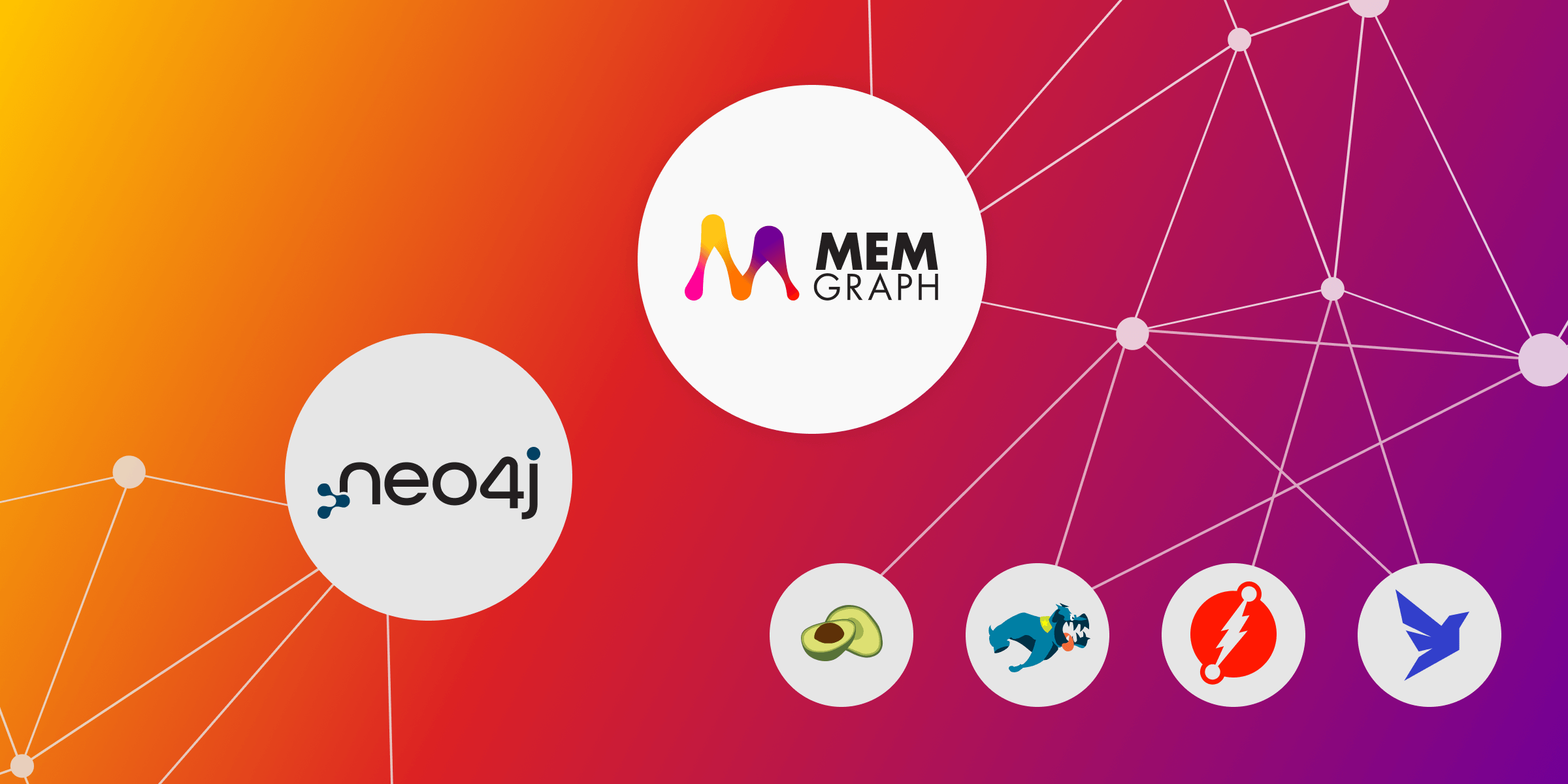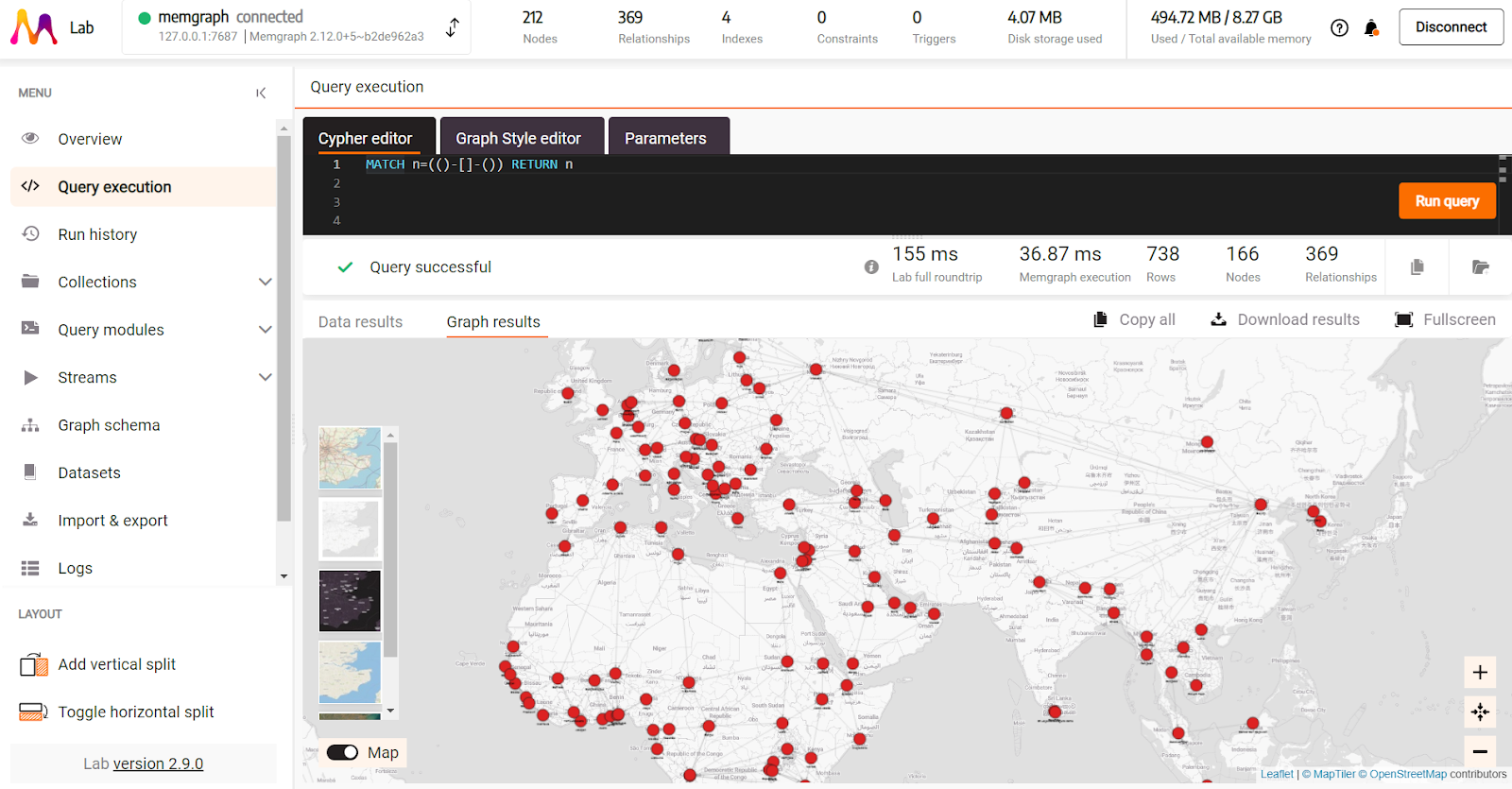
Neo4j Alternative: What are My Open-source Database Options?
Selecting the appropriate database is a crucial decision for developers initiating a project, whether it’s a simple web app or a complex project. The database can significantly impact a project's trajectory and performance. In this article, we will present to you various alternative databases to Neo4j, showing their technical features and use cases most suitable for your current needs.
Memgraph
Memgraph stands out as a high-performance open-source graph database that is compatible with Neo4j while eliminating Neo4j complexity and cost. Serving as a great alternative, it is designed specifically for real-time graph processing and analytics. With its advanced features, including high-performance graph algorithms, support for complex graph queries and an intuitive graph visualization tool called Memgraph Lab, it presents itself as an ideal choice for organizations that require real-time graph analytic capabilities.

Features of Memgraph
Memgraph offers features and advantages that set it apart in the world of graph databases. Some of those features and attributes include:
Speed: Memgraph is 8x faster than Neo4j in read-heavy, and 50x faster in write-heavy workloads. This ensures that data retrieval and manipulation are done with unparalleled execution.
Compatibility with Neo4j: Memgraph is a drop-in replacement for Neo4j providing users with the flexibility to transition without compromising on familiar tools and functionalities. The support for complete Cypher and Bolt compatibility ensures a smooth migration experience for users used to Neo4j's querying language and communication protocol.
In-memory processing: Memgraph operates entirely in-memory, providing fast read and write access, making it suitable for applications requiring low latency and real-time processing.
Cypher Query Language: Memgraph uses the Cypher query language, a graph query language specifically designed for expressing queries on graph data. Cypher simplifies the process of querying and traversing graphs.
Advanced algorithms: along with a lot of crucial built-in algorithms, Memgraph also offers highly performant advanced algorithms within a MAGE library.
Maximized throughput: Memgraph was built from the ground up in C++ to use the latest advances in hardware capabilities and deliver optimal performance.
ACID compliance: offers on-disk persistence, atomicity, consistency, isolation, and persistent durability with the assurance of data integrity and reliability.
Open-source: Memgraph is open-source without a no-nonsense enterprise license with no hidden costs. This transparent model fosters a collaborative community, allowing users to access code, report issues and contribute to the source code freely.
Best use-cases
Cybersecurity - Prevent cyber attacks by efficiently storing interconnected data and identifying the sources, patterns and chains of malicious attacks.
Fraud detection - Expose fraudulent claims, and eliminate chargeback fees and unrecoverable fraud in real time. Enhance your fraud system by mining relationships between entities.
Knowledge graph - Integrate disparate data sources into unified knowledge graphs to extract new knowledge and enhance collaboration among peers.
Recommendation engine - Predict customer behavior and make accurate product recommendations.
Identity and access management - Memgraph is a graph database that enables developers to build IAM systems that can track complex permissions and check access rules in milliseconds at scale.
Energy management systems - Manage your energy network systems and provide a stable and reliable service.
Network resource optimization - Answer questions about your network with graph analytics and make impactful decisions.
Data lineage - Ensure the reliability of your data and prevent its misuse.
ArangoDB
ArangoDB is an open-source NoSQL multi-model database system that supports graph, document, and key-value data models. It is designed to handle and query complex relationships within and between datasets. Below are some key features and advantages of ArangoDB:
Features of ArangoDB
Multi-Model Database: ArangoDB supports multiple data models, including document, graph, and key-value, allowing developers to choose the best model for their specific use case.
Native Graph Database: ArangoDB provides native graph capabilities, making it well-suited for applications with highly interconnected data, such as social networks and recommendation systems.
JSON Data Modeling: Documents in ArangoDB are stored in JSON format, providing flexibility in data modeling. It supports nested documents and arrays, making it suitable for a variety of data structures.
ACID Transactions: ArangoDB supports ACID (Atomicity, Consistency, Isolation, Durability) transactions, ensuring data consistency and reliability even in the case of failures.
Best use-cases
Multi-Model Requirements: When a project requires flexibility in data modeling and supports multiple data models, ArangoDB provides a unified solution.
Document Store Applications: Applications that benefit from a document-oriented data model, such as content management systems or e-commerce platforms, can leverage ArangoDB's document store capabilities.
Real-Time Analytics: ArangoDB is suitable for scenarios that demand real-time analytics, thanks to its ability to perform complex queries.
Microservices Architecture: The Foxx microservices framework makes ArangoDB a good choice for projects following a microservices architecture, simplifying development and deployment.
Dgraph
Dgraph is an open-source, distributed, native graph database designed for managing and querying highly connected data. It is specifically built to handle complex relationships in data, making it suitable for applications that require efficient graph traversals. Here are some key features, advantages, and best use cases for Dgraph:
Technical features
Native Graph Database: Dgraph is designed from the ground up as a native graph database, making it optimized for handling graph data and relationships.
GraphQL-like Query Language: Dgraph uses a GraphQL-like query language called GraphQL+-, which provides a powerful and intuitive way to query and manipulate graph data.
Distributed Architecture: Dgraph is built with a distributed architecture, allowing it to scale horizontally across multiple nodes, providing high availability and fault tolerance.
ACID Transactions: Dgraph supports ACID transactions, ensuring data consistency and reliability even in the face of failures.
Real-Time GraphQL Endpoint: Dgraph provides a real-time GraphQL endpoint, enabling developers to build GraphQL APIs directly on top of their graph data.
Best use-cases
Graph-Based Applications: Dgraph is particularly well-suited for applications that heavily rely on graph data, such as social networks, knowledge graphs, and recommendation systems.
Real-Time Analytics: Applications requiring real-time analytics and insights from highly connected data can benefit from Dgraph's efficient graph traversals.
Content Recommendation Systems: Dgraph's graph database capabilities make it suitable for building content recommendation systems where relationships between users and content are crucial.
Network Analysis: Dgraph is well-suited for network analysis applications, including fraud detection, network security, and identifying patterns in interconnected data.
IoT and Connected Devices: Applications dealing with the Internet of Things (IoT) and connected devices, where relationships and dependencies are critical, can leverage Dgraph for efficient data modeling and querying.
Stardog
Stardog is an enterprise-grade Knowledge Graph platform that combines a graph database, reasoning engine, and data virtualization capabilities. It allows organizations to model, store, and query complex interconnected data, providing a foundation for building intelligent applications. Here are some key features, advantages, and best use cases for Stardog:
Technical features
Knowledge Graph: Stardog is designed to manage knowledge graphs, representing data as a graph with entities and relationships, enabling sophisticated modeling of interconnected information.
OWL Reasoning: Stardog supports OWL (Web Ontology Language) reasoning, allowing for the inference of implicit knowledge based on explicit data, and enhancing the expressiveness of queries.
SPARQL Query Language: Stardog uses the SPARQL query language, a standard query language for querying RDF (Resource Description Framework) data. SPARQL allows users to express complex queries over the knowledge graph.
Virtual Graphs: Stardog supports virtual graphs, enabling the integration of diverse data sources, both internal and external, into a unified view without physically moving the data.
Data Virtualization: Stardog provides data virtualization capabilities, allowing users to query and access data without being constrained by the physical location of the data. This is especially useful in heterogeneous data environments.
ACID Transactions: Stardog ensures data consistency and reliability through support for ACID (Atomicity, Consistency, Isolation, Durability) transactions.
Security and Access Control: Stardog includes robust security features, allowing organizations to control access to sensitive data and enforce fine-grained access policies.
Best use-cases
Life Sciences and Healthcare: Stardog is well-suited for applications in life sciences and healthcare, where complex relationships and ontology-based reasoning are essential for data integration and analysis.
Financial Services: In the financial services sector, Stardog can be used for building knowledge graphs to represent customer relationships, transactions, and regulatory compliance data.
Government and Intelligence: Government agencies and intelligence organizations can leverage Stardog for managing and querying large-scale knowledge graphs to extract insights and relationships from diverse data sources.
Data Integration and Virtualization: Organizations with diverse data sources and a need for a unified view can use Stardog's data integration and virtualization capabilities to create a coherent information landscape.
Semantic Search and Recommendation: Stardog is suitable for applications involving semantic search and recommendation systems, where the inference of implicit knowledge enhances the relevance of search results and recommendations.
Fauna
Fauna is a distributed document-relational database delivered as a cloud API designed for modern applications. It provides a flexible, multi-model database with ACID transactions, making it suitable for a wide range of use cases.
Technical features
Multi-Model Database: Fauna supports multiple data models, including document, relational, and graph models, allowing developers to choose the most suitable approach for their application.
Global Distribution: Fauna is built for global distribution, ensuring low-latency access to data from anywhere in the world. This is particularly advantageous for applications with a global user base.
ACID Transactions: Fauna ensures the consistency and reliability of your data by providing ACID (Atomicity, Consistency, Isolation, Durability) transactions. This is crucial for applications where data integrity is paramount.
Serverless Architecture: Fauna operates in a serverless environment, meaning developers don't need to manage infrastructure. The database scales automatically based on demand, making it easier to handle varying workloads.
Real-Time Data: Fauna supports real-time data synchronization, making it suitable for applications that require live updates and collaboration features.
Security: Fauna includes robust security features, including encryption in transit and at rest, access control, and authentication mechanisms, ensuring the confidentiality and integrity of your data.
Best use-cases
Global Applications: Fauna is well-suited for applications with a worldwide user base, ensuring low-latency access to data from different geographic locations.
Real-Time Collaboration: Applications requiring real-time collaboration, such as collaborative editing or messaging platforms, benefit from Fauna's real-time data synchronization.
E-commerce Platforms: Fauna's scalability and ACID transactions make it a good fit for e-commerce applications where data consistency and reliability are crucial.
Content Management Systems (CMS): Fauna's flexibility in supporting multiple data models makes it suitable for content-rich applications like CMS, where different types of data need to be managed.
IoT (Internet of Things) Applications: The ability to handle large amounts of data and provide real-time updates makes Fauna suitable for IoT applications that require quick and reliable access to sensor data.
Financial Applications: Fauna's ACID transactions make it a strong contender for financial applications where data accuracy and consistency are non-negotiable.
Takeaway
Choosing the right database is a critical decision for developers embarking on a project, impacting its trajectory and performance. Among the alternative databases to Neo4j, Memgraph excels in performance, scalability and ease of use, making it the preferred option for many developers. Its robust features and efficient query processing makes it stand out in database technology. If you’re considering migrating from Neo4j to Memgraph or have any questions about the transition process, feel free to join us on Discord and engage in conversation, raise an issue on GitHub or star Memgraph’s repository :)